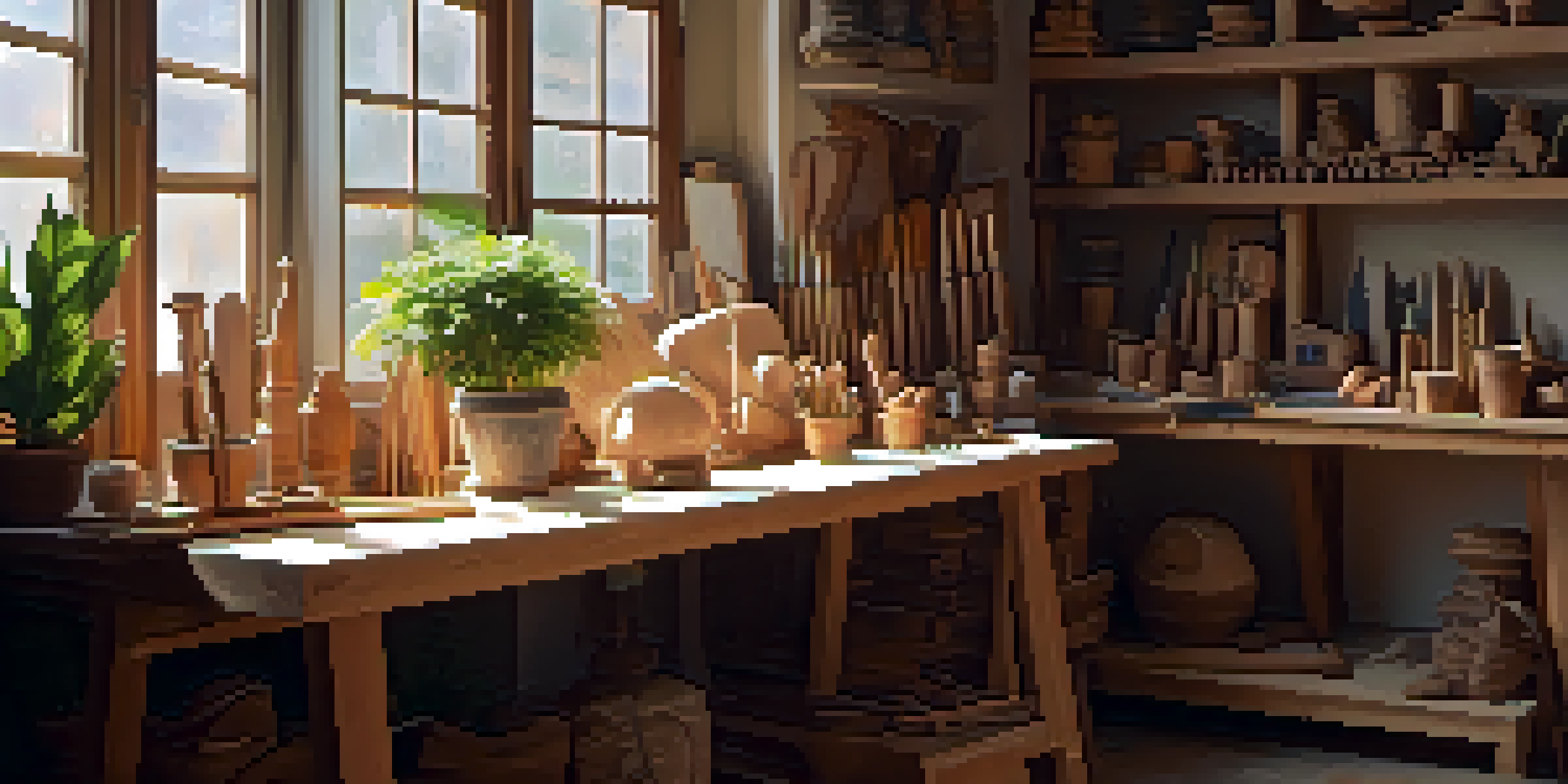Mindfulness in Carving: A Path to Emotional Resilience

What is Mindfulness and Why It Matters?
Mindfulness is the practice of being present and fully engaged in the moment. It helps people develop an awareness of their thoughts, feelings, and bodily sensations. This awareness can lead to reduced stress and improved emotional regulation, making it a valuable practice for everyone.
Mindfulness isn't difficult. We just need to remember to do it.
When we practice mindfulness, we cultivate a greater understanding of ourselves and our reactions to the world around us. It encourages a non-judgmental attitude, allowing us to observe our experiences without getting overwhelmed. This skill is crucial in today’s fast-paced society, where distractions are ubiquitous.
Incorporating mindfulness into daily activities can lead to enhanced emotional resilience. By learning to stay grounded in the present, we can better manage stress and navigate life’s challenges with greater ease and clarity.
Carving: An Art Form That Encourages Focus
Carving is more than just a craft; it's a meditative practice that demands focus and attention. As you shape wood or stone, you become immersed in the textures and forms, which naturally draws your mind away from external distractions. This immersive experience creates a perfect environment for mindfulness.

The repetitive motions involved in carving can have a calming effect on the mind, similar to the way meditation works. With each stroke of the tool, you can find a rhythm that helps to quiet racing thoughts and foster a deep sense of concentration. This focused attention is key to building emotional resilience.
Mindfulness Enhances Emotional Resilience
Practicing mindfulness helps individuals develop awareness of their thoughts and feelings, leading to better emotional regulation and reduced stress.
Moreover, the act of carving allows for a tangible expression of creativity, which can be incredibly therapeutic. As you see your ideas take shape, you experience a sense of accomplishment that boosts your emotional well-being and reinforces your capacity to cope with stress.
The Connection Between Mindfulness and Carving
When carving, the act itself encourages a mindful state. You must be aware of your movements, the pressure applied, and the details of your work. This heightened awareness fosters a connection between your mind and body, promoting emotional stability and resilience.
The creation of something new is not accomplished by the intellect but by the play instinct acting from inner necessity.
Mindfulness in carving also involves being present with the materials you use. Engaging with the grain of the wood or the coolness of stone can deepen your appreciation for the process and its outcomes. This connection can help you to cultivate patience and acceptance, valuable traits when facing emotional challenges.
Ultimately, the synergy between mindfulness and carving can lead to profound personal insights. As you carve, you might uncover feelings or thoughts that need attention, allowing for a deeper understanding of your emotional landscape.
Carving as a Therapeutic Practice
Carving is increasingly recognized for its therapeutic benefits. Art therapy, which includes carving, can help individuals process emotions and experiences in a non-verbal way. This can be especially beneficial for those who find it difficult to articulate their feelings.
Through carving, one can channel emotions into a creative outlet, transforming anxiety or frustration into something tangible and beautiful. This process can be incredibly empowering, helping individuals reclaim a sense of control over their emotional state.
Carving as a Mindful Practice
The act of carving encourages a focused, meditative state, allowing for a deeper connection to emotions and the creative process.
Additionally, the act of creating something from raw materials can instill a sense of purpose and achievement. This can bolster self-esteem and emotional resilience, making carving a valuable practice for mental well-being.
Mindfulness Techniques to Enhance Carving Skills
To maximize the benefits of mindfulness while carving, consider implementing specific techniques. Start by taking a few deep breaths before you begin; this can help center your mind and prepare you for the task at hand. Focusing on your breath is a simple yet effective way to cultivate mindfulness.
As you carve, pay attention to the sensations in your hands and the sounds of the tools. Notice how the wood feels beneath your fingertips or how the chisel glides through the material. Engaging your senses fully can enhance your experience and keep you anchored in the present moment.
Lastly, reflect on your carving process after you finish. Take a few moments to consider what you felt, learned, and experienced during the session. This reflection can deepen your connection to the practice and reinforce the emotional resilience gained through mindfulness.
Creating a Carving Space for Mindfulness
Setting up a dedicated carving space can significantly enhance your mindfulness practice. Choose a quiet area where you can work without interruptions, and arrange your tools and materials within easy reach. A comfortable and organized space allows you to focus completely on the act of carving.
Consider adding personal touches that inspire creativity, such as plants, artwork, or calming colors. This environment can foster a sense of peace and encourage deeper engagement with your work. A mindful space helps you transition into a more relaxed and focused state of mind.
Creating a Mindful Carving Space
Establishing a dedicated and serene carving space enhances mindfulness, promoting a peaceful environment that supports emotional expression and resilience.
Lastly, remember that the atmosphere you create can influence your emotional state. A serene carving space can promote feelings of safety and comfort, making it easier to express emotions and enhance your resilience as you work.
Embracing the Journey of Mindfulness in Carving
Mindfulness in carving is not just about the end product; it's about embracing the journey and the process. Each moment spent carving is an opportunity to learn, grow, and connect with your emotions. This perspective can transform how you approach both your craft and your emotional well-being.
As you carve, allow yourself to experience the highs and lows that come with the creative process. This acceptance of your journey fosters resilience, teaching you to navigate life's challenges with greater ease. Remember, it's perfectly okay to make mistakes; they are all part of the learning experience.

Ultimately, carving becomes a metaphor for life: it requires patience, practice, and presence. By embracing mindfulness in your carving practice, you are not only honing your skills but also building a strong foundation for emotional resilience that can carry you through various aspects of life.